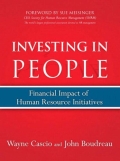
In their book, Investing in People: Financial Impact of Human Resource Initiatives authors Wayne Cascio and John Boudreau hit on something I’ve written about elsewhere: making research understandable and meaningful to a wider audience, especially in the context of business. In other words, putting dollar signs in there.
After some introductions and defining of terms, the authors propose what the call a “LAMP” framework for approaching the measurement of Human Resources initiatives. LAMP is an acronym for a paradigm relating to planning and couching research projects in terms those folks in Operations or Accounting will actually care about. You must have a coherent Logic for the initiative and how it connects to the larger business, the right Analytics to make sense of the data, the right Measures to gather the data in the first place, and the right Processes to make use of what you discover.
This framework established, the next chunk of the book dealt with very specific questions that I-O psychologists working in the area of Human Resources are likely to be called upon to answer. How much does employee absenteeism really hurt the company? How worried should we be about our turnover? Is it going to benefit the company to put in a new fitness center for employee use or to pay for a smoking cessation program? Is it worth it to offer on-site day care for employees to use in emergencies? How concerned should I be about these employee satisfaction survey results? Just how bad ARE the hyena attacks on the third floor?
The authors provide logic, measures, analytics, and processes for each issue to educate the reader on how to approach each question as both a scientist and a business person. Good research methods, theory building, and scientific interpretation of results are stressed, but so is communicating the outcomes in terms of dollars (or whatever your local currency may be). If you need a formula for calculating the hourly cost of turnover or absenteeism, for example, you’ll find it here.
The next major part of the book dives head first into the complicated (and often controversial) concept of staffing utility. The authors provide information on measuring and using staffing utility, then its use in decision making processes for things like enhanced selection systems and HR development programs. This section of the book is not for the faint of heart as it contains some pretty complicated algebra and calls to do some pretty challenging measurement. Here, let’s look at Equation 11-10 here:
![]()
I mean, sweet jeebus, what is THAT? Well, they tell you, or at least try to. And utility (pun intended) of this kind of effort can’t be understated when you are trying to sell a program to key decision makers or to communicate the impact of a new program.
So in general I liked Investing in People, even if it bogs down from time to time and once or twice the reader is presented with instructions that basically amount to “just make a best guess and plug the number in to your model.” But the message of how to communicate and debate with stakeholders in their own language and on their home turf is an invaluable one if Human Resources in general and I-O psychology in specific is going to move forward and become a real driving force in business.
I have Cascio’s earlier edition of this book. Costing Human Resources. It is a great resource to have. Didn’t see enough new content in this one to spend the money.